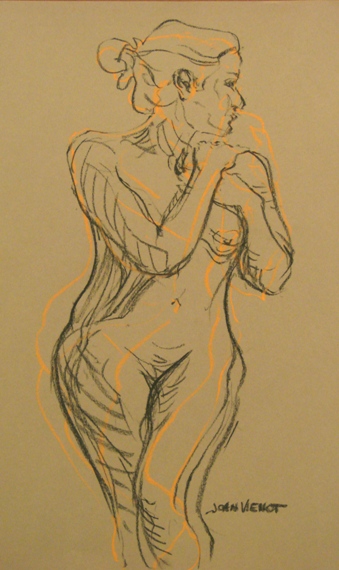
I need to warm-up for a little while before my efforts at figure drawing start to flow naturally. During the initial warm-up period, I try to capture the general directional line of the model, and a few of the light and dark patterns, or perhaps some of the essential contours or textures. Often it feels like I am drawing a stick figure, just trying to get the general angles and proportions correct. I draw fast, because our warm-up drawings start with 30-second or 1-minute or two-minute poses. The model often takes slightly off-balance or less comfortable poses during the warm-up period, knowing that he or she doesn’t have to hold them for long. I find that effort on the part of the model inspiring, and it motivates me to try harder. I usually use the broad side of a chalky medium for the warm-up drawings, sometimes even drawing with white nupastel, which helps me to see where the light is striking the model, though white alone usually doesn’t photograph well enough to post here in my blog. I draw with minimal concern for accuracy, sometimes merely trying to switch gears, from the left-brained thinking about my day-job as I drove to the session, to the right-brain activity of figure drawing. Drawing is first of all a physical activity, so like an athlete, an artist needs to work at it a little in order to coordinate the hand with the eye, and a period of warm-up drawings helps with that.
As you can see by the examples below, warm-up gestures have strange lines, curves going the wrong direction, places that get overdeveloped, and other places not drawn at all, wrong proportions, and yet an undeniable essence of the figure. These are warm-up gestures of the same pose from this past week’s figure drawing session at Studio b: one by me, one by Nancy Nichols Williams, and one by Steve Wagner.
I enjoy the time spent warming-up, but 2-minutes is always too short. But then too, 5 minutes is too short, and so is 20 minutes, and come to think of it, rarely is a pose long enough for me to feel like I actually finished! The next drawings include another of my warm-up gestures, and then two longer drawings, perhaps 20-minutes or 30 minutes. I left early from this session, exhausted from teaching all day, the 2nd of a 2½ day crash-course that I teach at a nearby college, certifying swimming pool operators to meet health department requirements.
 |
 |
 |
Most of my images are available for purchase. Contact me if you are interested. — Joan Vienot

























